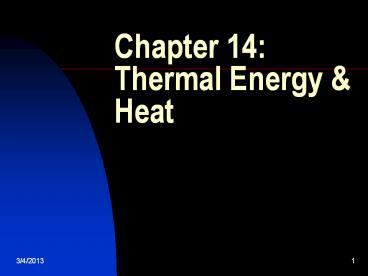Chapter 14: Thermal Energy & Heat - PowerPoint PPT Presentation
1 / 27
Title:
Chapter 14: Thermal Energy & Heat
Description:
Chapter 14: Thermal Energy & Heat Introduction Heat is the transfer of thermal energy. Topics of Discussion Temperature and Thermal Energy (Section1) The Nature of ... – PowerPoint PPT presentation
Number of Views:492
Avg rating:3.0/5.0
Title: Chapter 14: Thermal Energy & Heat
1
Chapter 14 Thermal Energy Heat
2
Introduction
- Heat is the transfer of thermal energy.
3
Topics of Discussion
- Temperature and Thermal Energy (Section1)
- The Nature of Heat (Section 2)
- Thermal Energy and States of Matter (section 3)
- Uses of Heat (Section 4)
4
TEMPERATURE and THERMAL ENERGY(Section one)
- Temperature is the measure of the average kinetic
energy of the individual particles in an object. - Three common Temperature scales for measuring
temperature - Fahrenheit
- Celcius
- Kelvin
5
Fahrenheit
- U.S. System
- Water Freezes at 32o
- Water Boils at 212o
- 180 equal intervals between freezing and boiling
called degrees Fahrenheit (oF) - Absolute zero is -460o
6
Absolute Zero
- Absolute zero is the lowest temperature possible.
- At this temperature, no more energy can be
removed from matter. - -460oF
- -273oC
- 0 K
7
Celcius Scale
- This system is used in most of the world.
- Water Freezes at 0o
- Water Boils at 100o
- 100 equal intervals between freezing and boiling
called degrees Celcius (oC) - Absolute zero is -273o
8
Kelvin Scale
- This system is used most in physical science.
- The Kelvin scale is defined so that zero is
absolute zero. - Units on the Kelvin scale are the same size as
those in Celcius called kelvins (K) - Water Freezes at 273o
- Water Boils at 373o
- Absolute zero is 0o
9
Thermal Energy
- Temperature is a measure of the average kinetic
energy of the individual particles of matter. - Thermal energy is the total energy of all of the
particles.
10
The Nature of Heat(Section 2)
- Heat is thermal energy moving from a warmer
object to a cooler object. (Only One way.) - Heat is transferred by
- Conduction,
- Convection, and
- Radiation.
11
Conduction
- Heat is transferred from one particle of matter
to another without the movement of matter itself. - Ex A pot heating on a stove. The fast moving
(hot) particles of the element collide with the
slow (cold) particles of the pot and energy is
transferred.
12
Convection
- Heat is transferred by the movement of currents
within a fluid (liquid or gas.) - Ex Water heating in a pot on the stove.
- Differing densities cause the water to flow in a
convection current.
13
Radiation
- The transfer of energy by electromagnetic
radiation. - Radiation does not require matter to transfer
thermal energy. - Ex Heat from the sun, heat lamp, and a microwave
oven.
14
Conductors and Insulators
- Conductor A material that conducts (transfers)
heat well. - Ex metal.
- Insulator A material that does not conduct heat
well. - Ex Wood, Glass and gasses.
15
Specific Heat
- Specific Heat The amount of energy required to
raise the temperature of one kilogram of a
substance by 1 kelvin. - ? energy Mass X Specific heat X ?
temperature(? change)
16
Thermal Energy andStates of Matter(Section 3)
- Three States of matter
- Solids
- Liquids
- Gases
17
Solids
- Ex Ice cube text book
- Tightly packed particles
- Particles in fixed position (vibrate)
- Definite volume shape
18
Liquids
- Ex Water Molten steel
- Particles close together (further than solid)
- Particles can move around
- Definite volume, random shape
19
Gases
- Ex Steam air
- Fast moving / far apart particles
- Particles free to move
- Random volume, random shape(Expand to fit space
available)
20
Changes of State
- Change of state is the physical change from one
state to another. - Matter will change from one state to another if
thermal energy is absorbed or released. - Solid-Liquid
- Liquid-Gas
- Temperature constant
21
Solid LiquidChanges of State
- Melting
- From solid to liquid
- Thermal energy increases
- Melting point temperature at which a solid
changes to liquid - Freezing
- From liquid to solid
- Thermal energy decreases
- Freezing point temperature at which a liquid
changes to solid
22
Liquid - GasChanges of State
- Vaporization
- From liquid to gas
- Thermal energy increases
- Boiling point temperature at which a liquid
changes to gas - Condensation
- From gas to liquid
- Thermal energy decreases
23
Thermal Expansion
- As thermal energy of a substance increases, its
particles spread out and the substance expands. - Thermometers
- Expanding liquid Mercury or alcohol
- Thermostats
- Expanding bimetallic strips
24
Uses of Heat(Section 4)
- Heat Engines
- convert thermal energy to mechanical energy
- External Combustion Engines
- Fuel is burned outside the engine
- Internal Combustion Engines
- Fuel is burned in cylinders inside the engine.
25
Internal Combustion Engines
- Gasoline and Diesel
- Pistons move up and down (one stroke) to drive
crankshaft - Two Stroke
- Four- Stoke
- Intake Stroke, Compression Stroke
- Intake Stroke, Compression Stroke
- Ignition
- Power Stroke, and Exhaust Stroke
26
Refrigerators
- A refrigerator is a device that uses an outside
energy source to transfer thermal energy from a
cool area to a warm area.
27
Key Terms































